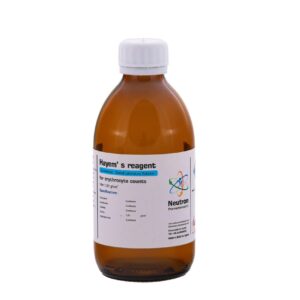KOVACS
| Density | 0.92q g/cm3 |
| HS Code | 38220000 |
| Storage | Store at +2 to + 8 °C |
| SDS | available |
| R Phrase | R 10-22-37/38-41-67 |
| S Phrase | S 26-39 |
| Odour | characteristic odour |
| Color | yellow – green |
| Form | liquid |
| Solubility in water | (20 °C ) soluble |
| Flash point | 36 °C |
| Appearance | Yellow to green | Conforms | |
| Identification | Conforms | ||
| Solubility | Conforms | ||
| Suitability for microscopy | Conforms |
Kovacs Reagent is a chemical solution used in microbiology to detect indole production by bacteria, particularly in the indole test as part of the IMViC series for differentiating Enterobacteriaceae.
🏭⚗️ Production
Kovacs reagent is prepared by dissolving para-dimethylaminobenzaldehyde (p-DMAB) in amyl alcohol (isoamyl alcohol) and concentrated hydrochloric acid. The mixture is stirred until fully dissolved and is typically stored in a dark, tightly sealed container to prevent light-induced degradation.
🔬 Properties
Kovacs reagent appears as a yellow to amber, oily liquid with a pungent odor. When added to a bacterial culture grown in tryptophan-rich medium, it reacts with indole (if present) to form a red or pink ring at the surface. This color change results from the formation of a rosindole dye complex, indicating a positive indole reaction.
🧪 Applications
Kovacs reagent is used in the indole test, an important biochemical assay to identify indole-producing bacteria such as Escherichia coli. A few drops of the reagent are added to the culture medium after incubation. The formation of a red layer at the top confirms a positive result, aiding in bacterial differentiation.
⚠️ Safety
Kovacs reagent contains concentrated hydrochloric acid and amyl alcohol, making it corrosive and flammable. It can cause severe burns and respiratory irritation. Always use in a fume hood with appropriate PPE, including gloves and eye protection. Store in a cool, dark, well-ventilated area away from heat or open flame.



